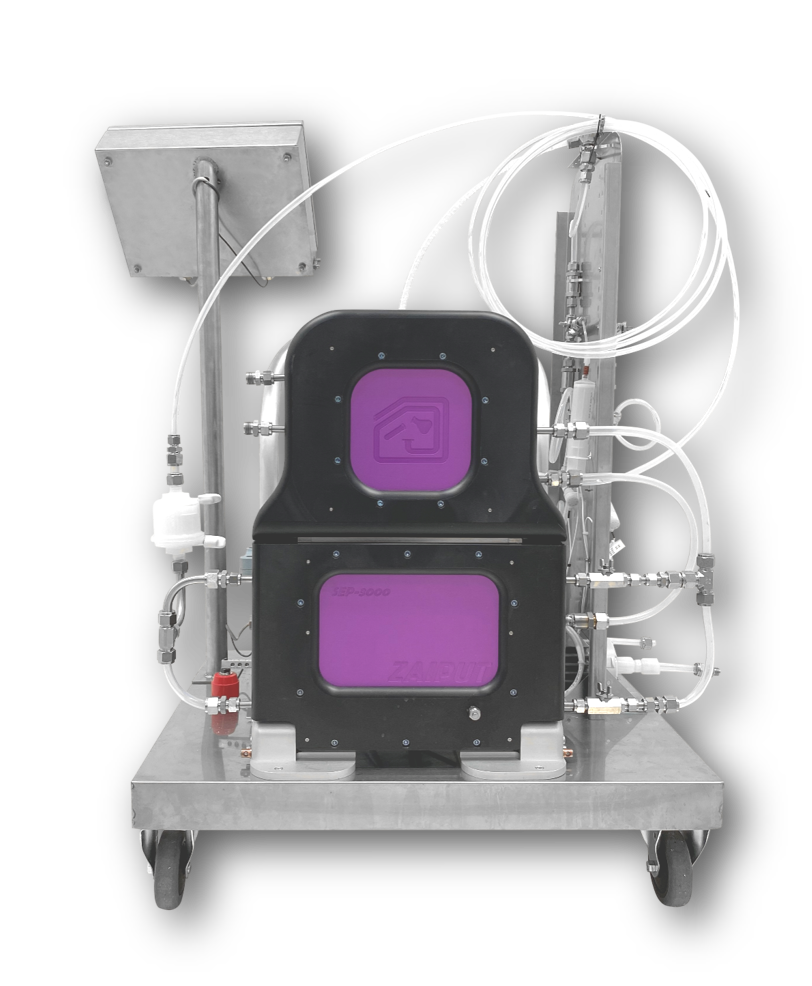
Separators
 |
SEP-3000 | 12 L/hr – 180 L/hr |
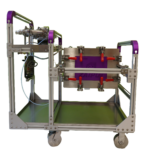 |
SEP-40K | 60 L/hr – 2,400 L/hr |
Integrated Extraction Platforms: Pumping, Mass Transfer & Separation
 |
ZFOX-3000 | 12 L/hr – 180 L/hr |
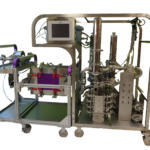 |
ZFOX-40K | 60 L/hr – 2,400 L/hr |
Zaiput separation technology is available at Production Scale, both as single separators for continuous or batch processes (SEP-3000, SEP-40K) and as integrated platforms for batch processes (ZFOX-3000, ZFOX-40K).
SEP-3000 and SEP-40K are the pilot and production scale versions of Zaiput’s membrane-based separators, available as plug-and-play passive separators.
Click here to discover our laboratory scale phase separators
Zaiput Integrated Batch extraction platform (ZFOX) is a platform that enables a hybrid (batch + continuous) approach to solvent extraction. The platform integrates Zaiput’s phase separator with pumping, engineered mass transfer (mixing) and controls to provide a turnkey solution for plant operators. This platform addresses the major challenges of batch-based liquid-liquid extraction.

In many industrial chemical manufacturing segments (Pharma, Fine/Specialty Chemicals, etc.) liquid-liquid extraction (LLE) represents a very common post reaction purification step. Extractions are often performed in the same vessel as the reaction, relying on time consuming mixing for mass transfer and even slower gravity driven phase separation.
While LLE is a well-established approach, from a production standpoint, there are 3 major shortcomings:
LLE in batch requires a reactor to have enough space to add the liquid phase used for the extraction. Hence when a reaction is followed by a solvent extraction, only half (or less) of the reactor volume is actually used for the reaction. This substantially reduces the productivity of a reactor, at least by a factor of 2.

Some processes require more than one extraction (or “wash”). Besides the low productivity, the sequential nature of the multiple washes multiplies the time needed. In other words, 2 extractions need twice the time, 3 extractions need three times the time, etc. This results in a production bottle neck from a time perspective.

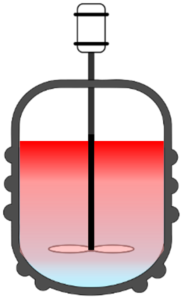
The current approach to LLE hinges on stirrers for mixing and on gravity as a driving force for separation of the liquid phases. Better mixing that gives smaller droplets and hence better mass transfer unfortunately results in a mixture that is harder to separate. Current approaches rely on striking a balance between better mass transfer and making systems easier to settle; this results in waste of time, material and leads to suboptimal process conditions that impact process time.
Zaiput’s Z-FOX continuous extraction platform solves these issues and more by integrating continuous membrane separation with engineered mass transfer. Now, reactors can be used to full
capacity as the extraction is taken out of the reactor, emulsions are easily and immediately separated, and multiple extractions can be carried out in the same amount of time as it takes to carry out one. Z-Fox is a small footprint, mobile platform that can easily be moved around the plant to service many reactors – a versatile continuous extraction solution to dramatically increase the output of previously installed capacity. Engineers and operators can reimagine their workflows and plant productivity with this new technology opening up a world where there is no more waiting for emulsions to settle, productivity goals are easily hit, and new extraction projects are easily scaled and implemented.
 |
SEP-40K | 60 L/hr – 2,400 L/hr |
Zaiput’s liquid-liquid/liquid-gas separators work by integrating selective wetting properties of a membrane with an in-line differential pressure controller.
Dual Wetting Technology® (DWT):
Zaiput’s innovative separation technology DWT provides unprecedented separation efficiency for the most challenging separations.

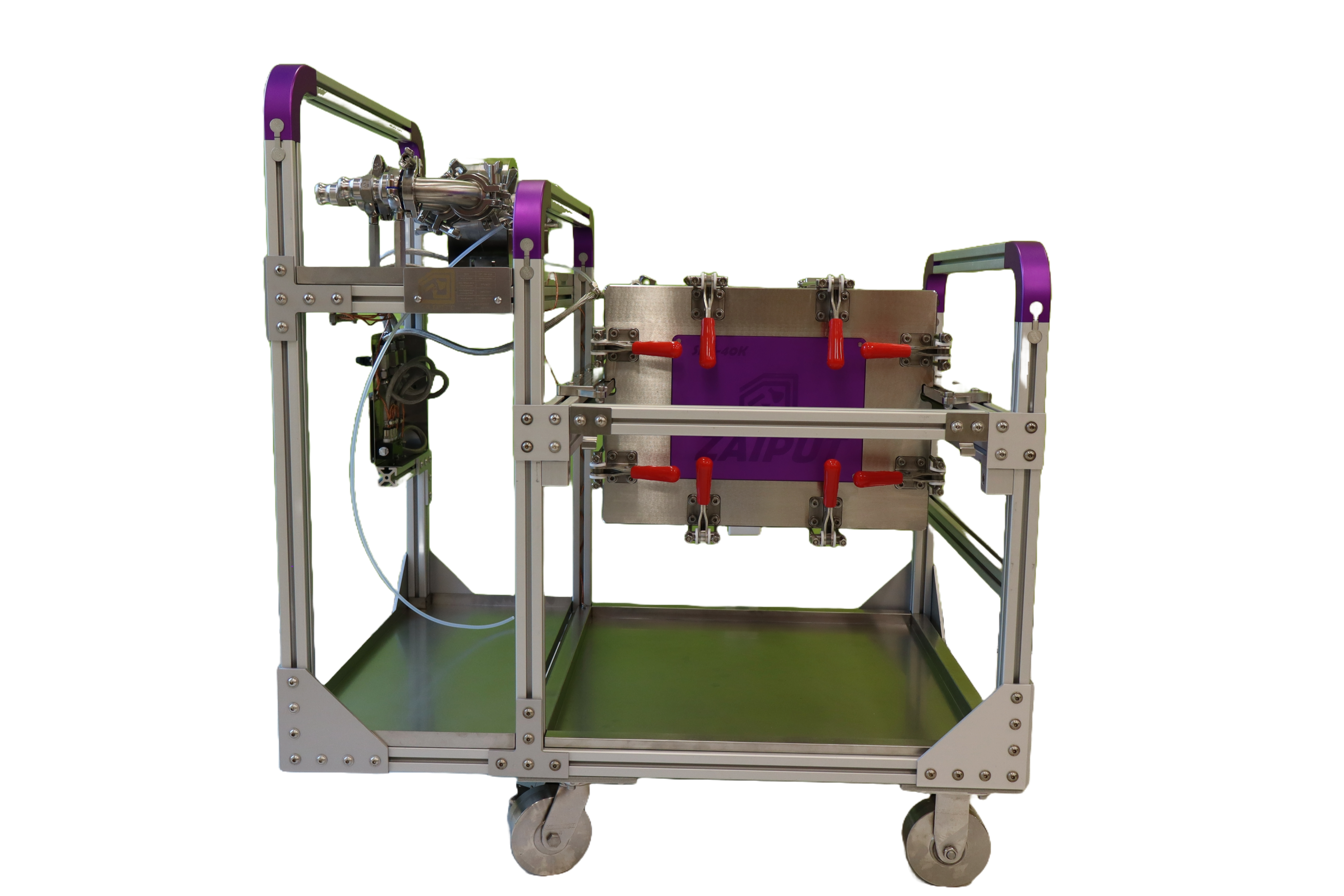
 |
SEP-3000 | 12 L/hr – 180 L/hr |
Zaiput’s liquid-liquid/liquid-gas separators work by integrating selective wetting properties of a membrane with an in-line differential pressure controller.
SINGLE WETTING TECHNOLOGY® (SWT):

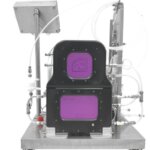 |
ZFOX-3000 | 12 L/hr – 180 L/hr |
 |
ZFOX-40K | 60 L/hr – 2,400 L/hr |
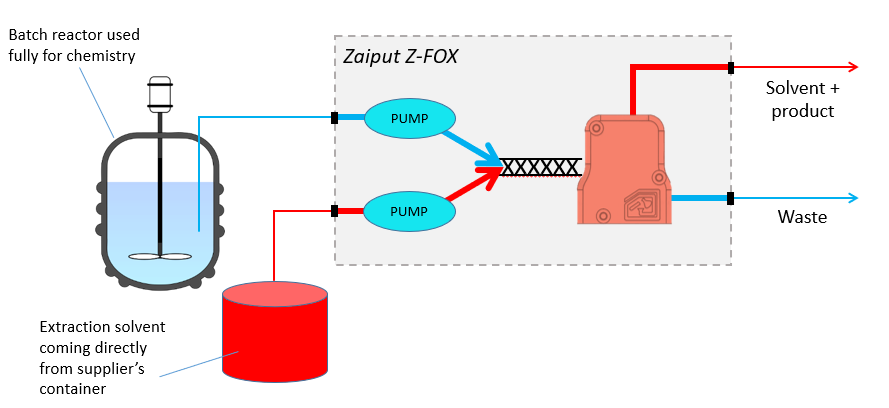
Z-FOX integrates Zaiput Flow Technologies patented separation technology with specifically engineered static mixers to provide both necessary parts of an extraction: mass transfer and phase separation.
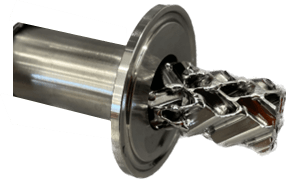
Static Mixers are highly effective at promoting mixing between biphasic systems by forcing droplet breakup with a high degree of turbulence leading to much larger mass transfer rates than other technologies. Droplet breakup increases the surface area between phases and decreases the characteristic length needed for diffusion (radius of a droplet). Zaiput has developed a diffusion based model to determine the adequate mixing condition required to come to theoretical equilibrium for any given extractive system – for more information Click Here.
Zaiput has simplified mass transfer sizing through the introduction of “Modular Mixing Units”. An MMU contains:
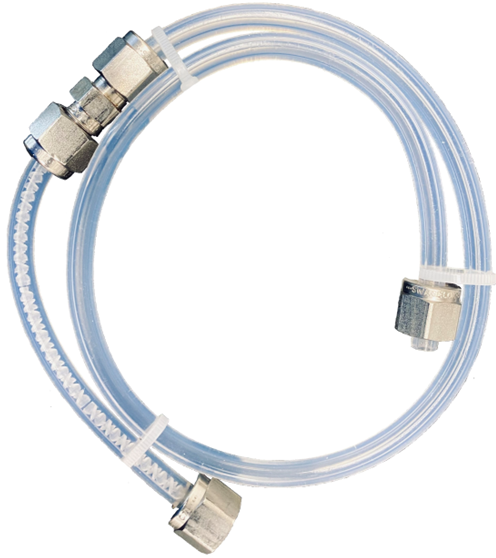
To determine how many MMUs are correct for your application, please see our sizing guide here.
The engineered mass transfer and membrane-based phase separation are integrated into an easy-to-use platform for a one-stop extraction solution. The platform includes pumps, controls, and sensors specified for hazardous environments and is built on a mobile platform designed to be used across the plant.
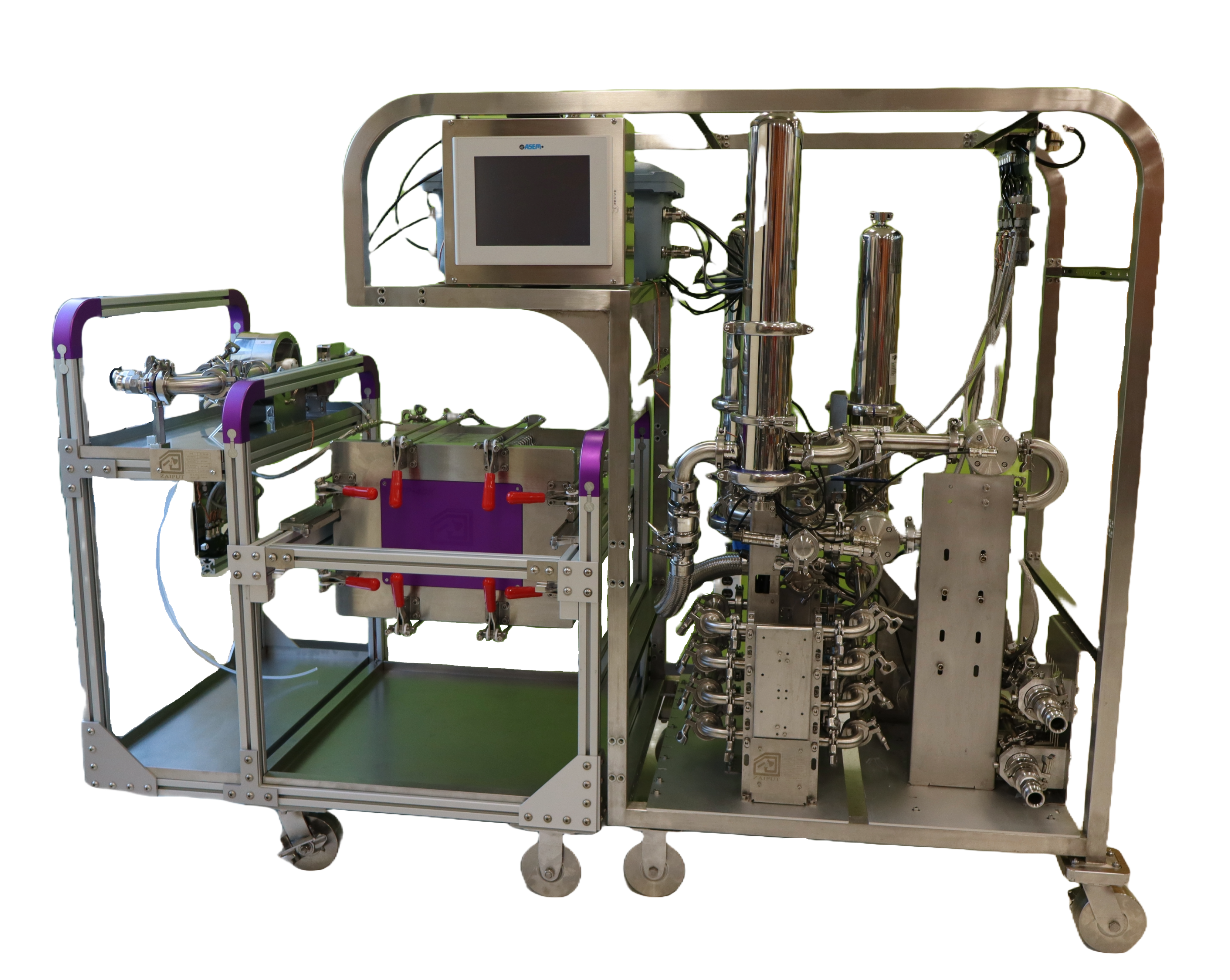

Traditionally, extractions are carried out in the same vessel as the reaction which brings about a host of inefficiencies, most obviously the loss of capacity in a reactor.

In traditional extractions, you need to wait while mixing, settling, and decanting occurs. For reasons of purity or yield, multiple extractions or washes may be needed, requiring further solvent addition, mixing, settling, and decanting all of which dramatically slow down a process.
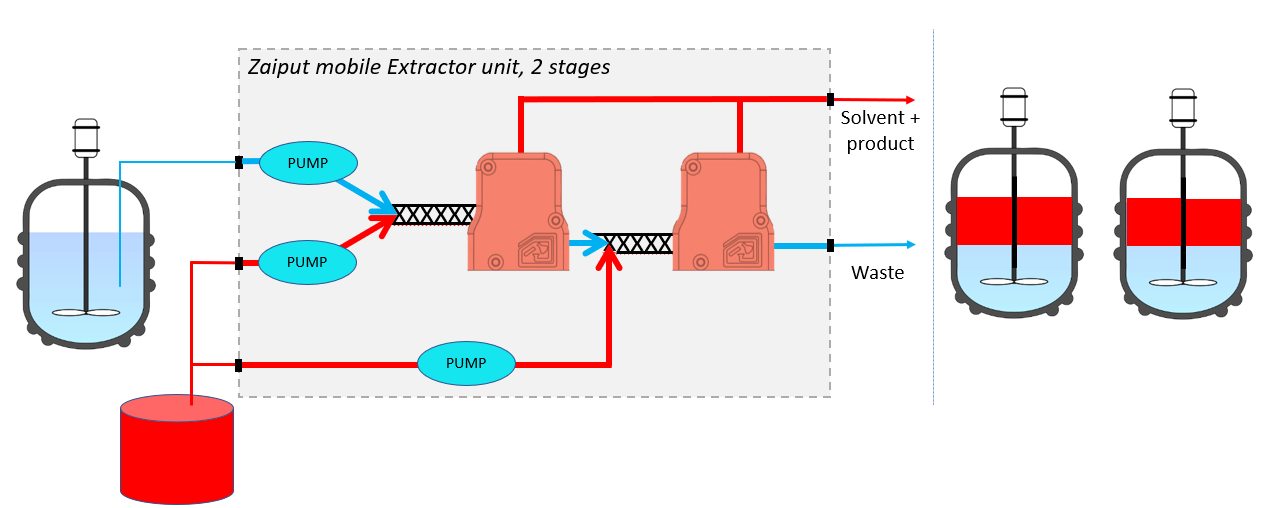
One of the biggest causes of inefficiencies in batch extractions is emulsion formation. Mixing must be carefully carried suboptimally in order to not emulsify a system.

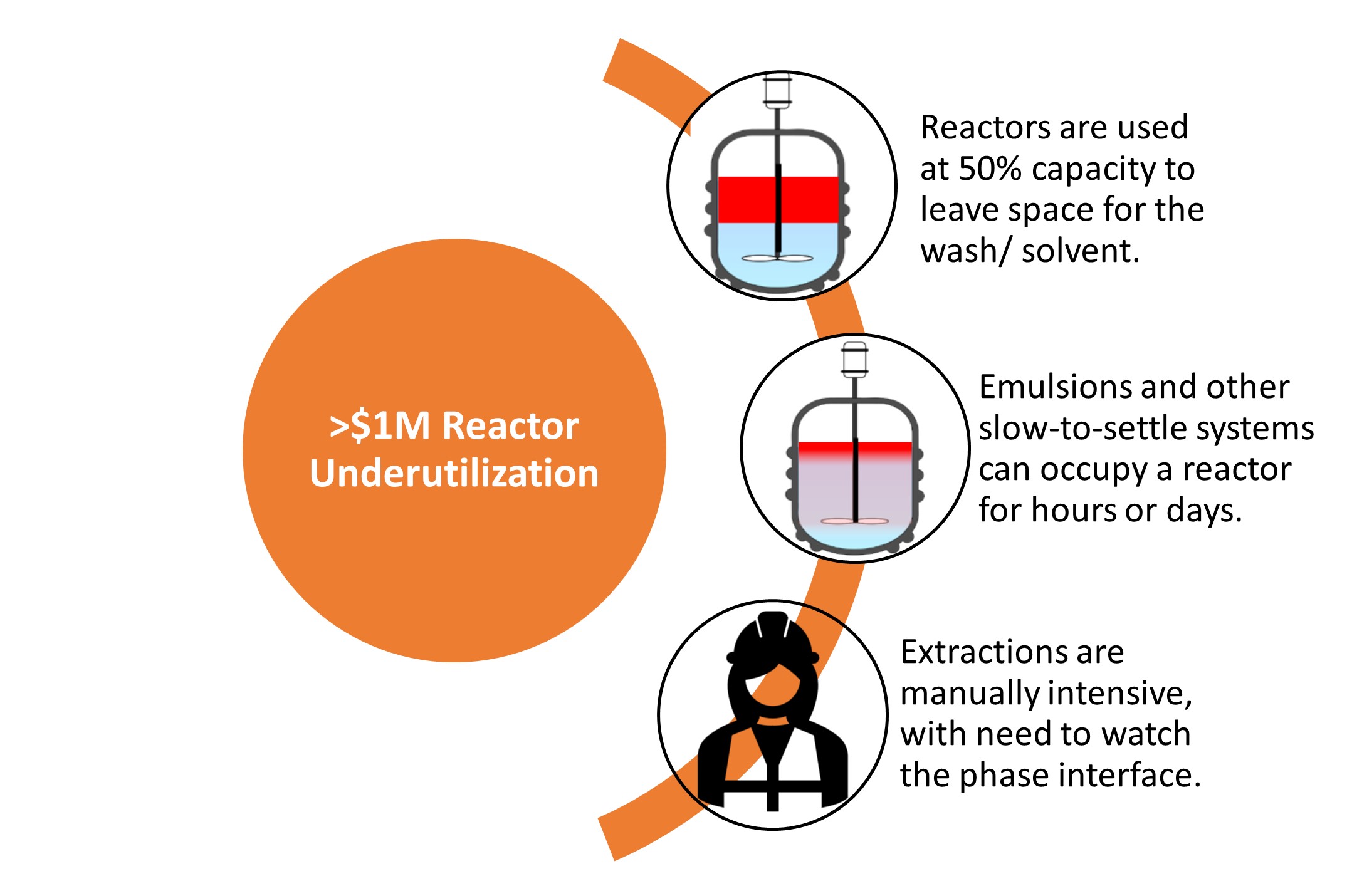
Batch reactors are commonly underutilized by companies that rely on them as both reaction and extraction vessels. They are the most valuable asset in a plant, capable of producing APIs, intermediates, and other products and yet we often don’t use them to their full capacity so that we can squeeze a workup or quench into the same vessel. This underutilization is compounded across the number of reactors in a plant, leading to tens of millions of sunk cost not generating the best potential returns.

Operators and plant managers waste thousands of hours every year optimizing mixing and settling conditions, waiting for mixing to occur, waiting for emulsions to settle & watching phase interfaces while a reactor drains. All of this is wasted time that can be better utilized both in terms of people and assets.
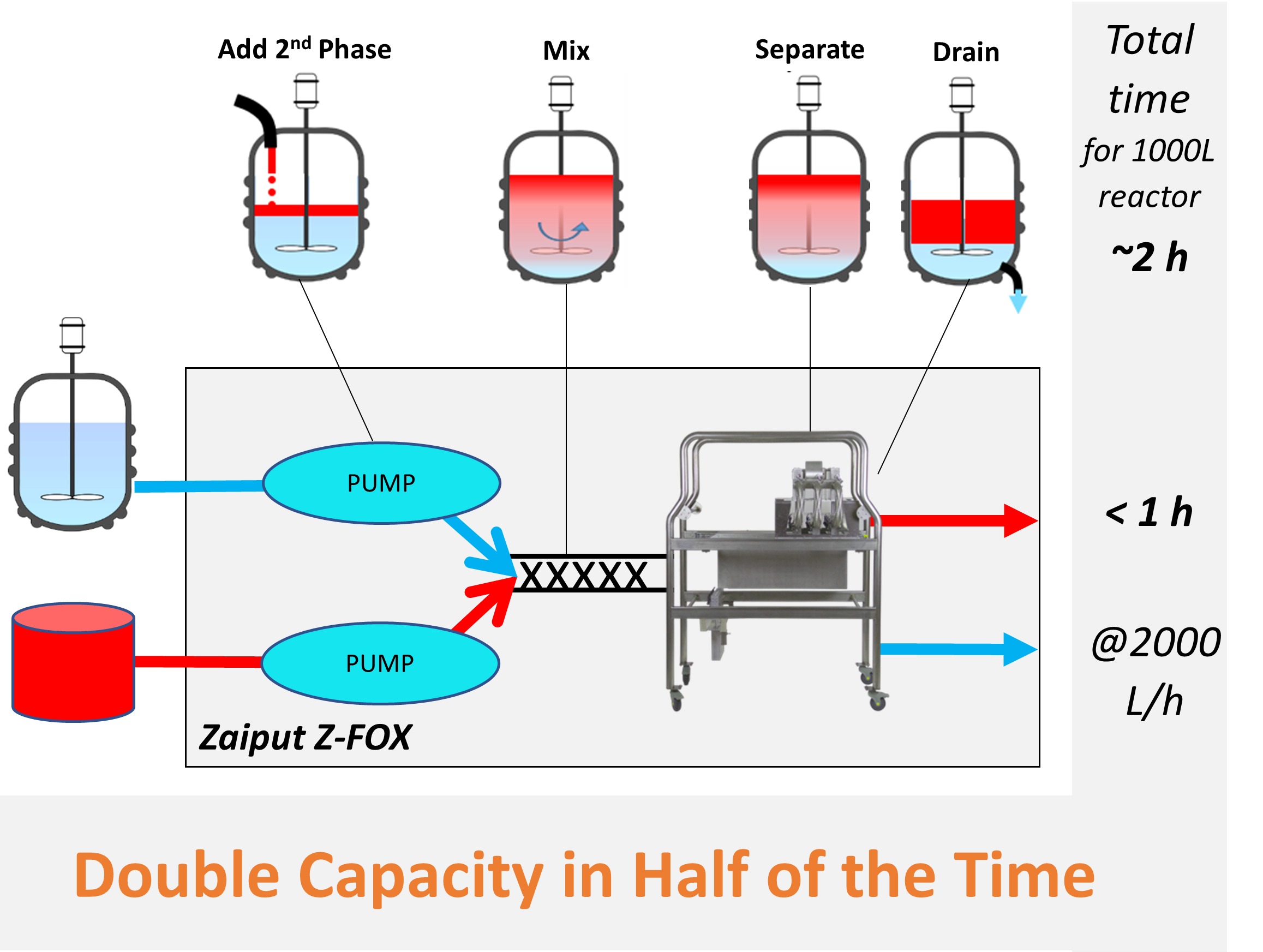
Zaiput improves plant productivity by taking the workup out of the reactor. Instead, the workup is carried out in-line by pumping directly out of solvent storage and teeing into the product before static mixing elements. Right away, this allows plant operators to double the capacity of their reactors while taking less time to carry out their extraction. The static mixers are specifically designed to give full mass transfer while the high throughput membrane separator simplifies phase separation. Brought together you get a fast, efficient extraction in less time.
Importantly for CDMOs, this will allow companies to bring in more projects and larger projects than their current capacity allows, which will directly translate to the bottom line. The technology is applicable across a wide range of solvent systems and can be easily implemented, with minor adjustments, from process to process.

Zaiput helps engineers and plant managers hit their continuous improvement and efficiency goals across a broad range of key parameters. From increasing product output to bringing in more projects and reducing loss from difficult separations, Zaiput helps you accomplish ambitious plant improvements.
If you’re interested in any of these benefits or curious about others, email us at Sales@Zaiput.com.
A variety of membranes for Zaiput’s separator are available to optimize separation performance and throughput. Membranes are available in both hydrophobic and hydrophilic, they are low cost and easy to replace.
The membranes for the SEP-40K are the same as the membranes for other devices except for a different, more functional packaging. The SEP-40K membranes are encapsulated in an easy-to-handle, plant-safe cartridge. The cartridge contains two membranes, one hydrophilic and one hydrophobic membrane.
Membranes for both the SEP-3000 and 40K are designed to be durable, easy to use, and low cost. They can be treated either as consumables or they can be cleaned.
Membrane selection process:
The key parameters for identifying a suitable membrane for separation are the interfacial tension between the two phases and the viscosity of the two phases (this influences the throughput of the device).
In general, the lower the interfacial tension, the smaller the pore size needs to be. However, a smaller pore size reduces the maximum viscosity that can be accommodated by the membrane. To find the membrane best for your application, please use the chart below or contact a Zaiput representative.
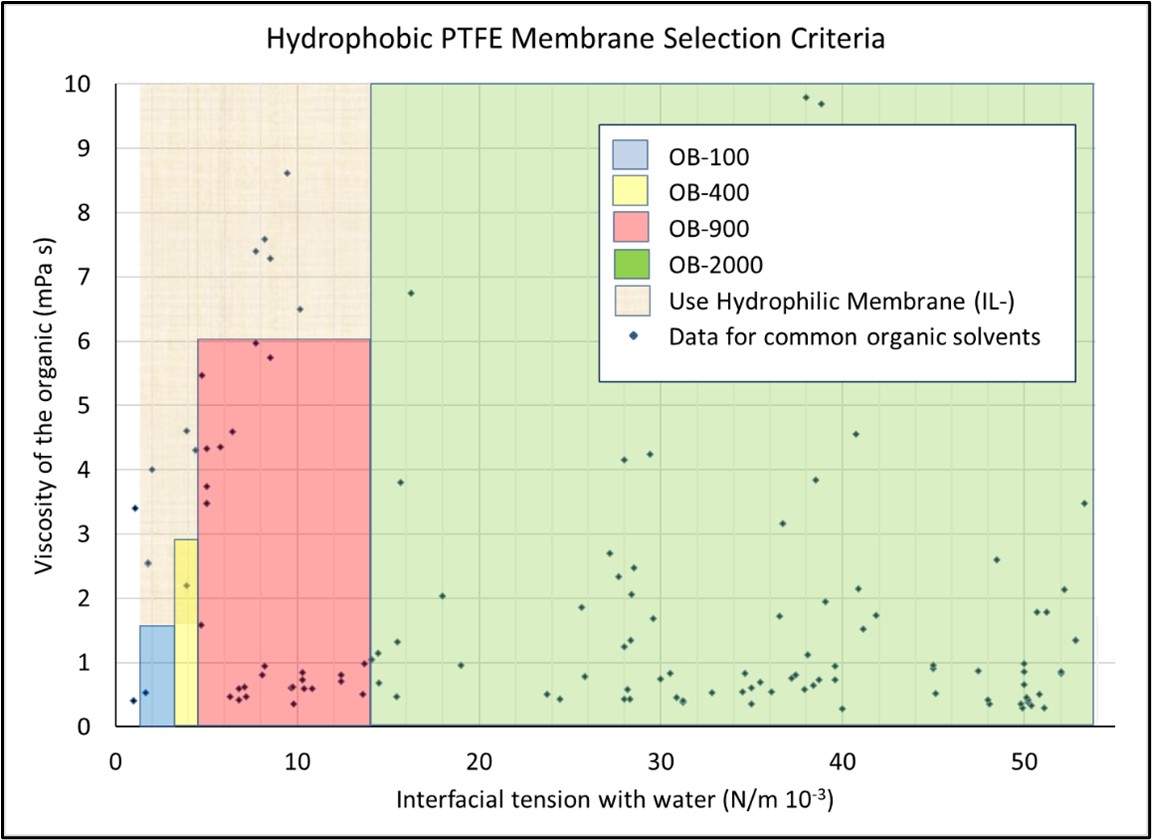
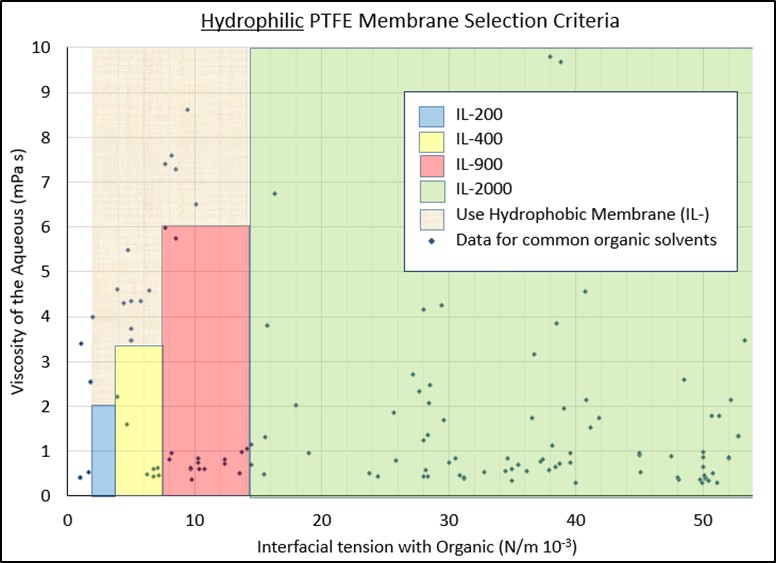


Contact us for the latest membrane offering
For general applications, we recommend reviewing the information in the Membrane Selection Guide.
If you have any questions, contact us at support@zaiput.com
Dimitrios Tsaoulidis, Milan Mamtora, Miguel Pineda, Eric S.Fraga, and Panagiota Angeli, Experimental and CFD scale-up studies for intensified actinide/lanthanide separations, Chemical Engineering and Processing – Process Intensification., Mar 2021.
Mellisa B. Sagandira, Cloudius R. Sagandira, and Paul Watts, Continuous flow synthesis of xylidines via biphasic nitration of xylenes and nitro-reduction, Journal of Flow Chemistry., Jan 2021.
Glen Surjadinata, Luke Hunter, Lidia Matesic, and Giancarlo Pascali, Analytical-scale synthesis of aryl-SF4Cl via flow microfluidic technology, Journal of Flow Chemistry., Jan 2021.
Samuel J. Miller, Haruro Ishitani, Yuichi Furiya, and Shu̅ Kobayashi, High-Throughput Synthesis of (S)-α-Phellandrene through Three-Step Sequential Continuous-Flow Reactions, Org. Process Res. Dev., Jan 2021.
Jillian W. Sheeran, Kiersten Campbell, Christopher P. Breen, Gerald Hummel, Changfeng Huang, Anamika Datta, Serge H. Boyer, Scott J. Hecker, Matthew M. Bio, Yuan-Qing Fang, David D. Ford, and M. Grace Russell, Scalable On-Demand Production of Purified Diazomethane Suitable for Sensitive Catalytic Reactions, Org. Process Res. Dev., Jan 2021.
Dimitrios Tsaoulidis, Milan Mamtora, Marta Mayals Gañet,
Eduardo Garciadiego-Ortega, and Panagiota Angeli, Scale-Up Studies for Co/Ni Separations in Intensified Reactors, Micromachines., Dec 2020.
Hoang Khang Bui, Ki Yoon Kim, Hyeonjin Kim, Jae‐Pyoung Ahn, Taekyung Yu, and Tae Seok Seo, Total Integration of the Sample Injection, Microdroplet Reaction, Phase Separation, Real‐Time Optical Detection, and Recovery of Diverse Silver–Gold Bimetallic Nanoalloys in a Continuous Process,Particle., Dec 2020.
Su Wang, Yeersen Patehebieke, Zheng Zhou, Zhibing Zhang, and Xiao Wang, Recent Advances in Continuous-Flow Reactions Using Metal-Free Homogeneous Catalysts,Catalysts, Nov 2020.
Piera De Santis, Lars-Erik Meyer, and Selin Kara, The rise of continuous flow biocatalysis – fundamentals, very recent developments and future perspectives, Reaction Engineering and Chemistry, Oct 2020.
Naoto Sugisawa, Hiroyuki Nakamura, and Shinichiro Fuse, Catalyst-free biphasic oxidation of Thiophenes in continuous-flow, Journal of Flow Chemistry, Jul 2020.
Jorge García‐Lacuna, Prof. Dr. Gema Domínguez, and Prof. Dr. Javier Pérez‐Castells, Flow Chemistry for Cycloaddition Reactions, ChemSusChem, Jul 2020.
Elizabeth Farrant Automation of Synthesis in Medicinal Chemistry: Progress and Challenges, ACS Med. Chem. Lett., Jul 2020.
Alejandro Mata, Ulrich Weigl, Oliver Flögel, Pius Baur, Christopher A. Hone and C. Oliver Kappe, Acyl azide generation and amide bond formation in continuous-flow for the synthesis of peptides, React. Chem. & Eng., Mar 2020.
Kristina Søborg Pedersen, Christina Baun, Karin Michaelsen Nielsen, Helge Thisgaard, Andreas Ingemann Jensen and Fedor Zhuravlev, Design, Synthesis, Computational, and Preclinical Evaluation of natTi/45Ti-Labeled Urea-Based Glutamate PSMA Ligand, Molecules, Mar 2020.
Peter Sagmeister, Johannes Poms, Jason Williams and C. Oliver Kappe, Multivariate analysis of inline benchtop NMR data enables rapid optimization of a complex nitration in flow, React. Chem. & Eng., Feb 2020.
Adam D. Clayton, Luke A. Power, William R. Reynolds, Caroline Ainsworth, David R. J. Hose, Martin F. Jones, Thomas W. Chamberlain, A. John Blacker & Richard A. Bourne, Self-optimising reactive extractions: towards the efficient development of multi-step continuous flow processes, Journal of Flow Chemistry, Feb 2020.
Victor-Emmanuel H. Kassin, Thomas Toupy, Guillaume Petit, Pauline Bianchi, Elena Salvadeo & Jean-Christophe M. Monbaliu, Metal-free hydroxylation of tertiary ketones under intensified and scalable continuous flow conditions, Journal of Flow Chemistry, Feb 2020.
Chetsada Khositanon, Kanyaporn Adpakpang, Sareeya Bureekaew & Nopphon Weeranoppanant, Continuous-flow purification of silver nanoparticles and its integration with flow synthesis, Journal of Flow Chemistry, Feb 2020.
Govaerts, S., Nyuchev, A. & Noel, T., Pushing the boundaries of C–H bond functionalization chemistry using flow technology, J Flow Chem, Feb 2020.
Antimo Gioiello, Alessandro Piccinno, Anna Maria Lozza, and Bruno Cerra, The Medicinal Chemistry in the Era of Machines and Automation: Recent Advances in Continuous Flow Technology, Journal of Medicinal Chemistry, Feb 2020.
V Volker Hessel, Nam Nghiep Tran, Sanaz Orandi, Mahdieh Razi Asrami, Michael Evan Goodsite, Hung T. Nguyen, Continuous-Flow Extraction of Adjacent Metals – a Disruptive Economic Window for In-Situ Resource Utilization of Asteroids?, Angewandte Chemie, Jan 2020.
Francesca Tentori, Elisabetta Brenna, Michele Crotti, Giuseppe Pedrocchi‐Fantoni, Maria Chiara Ghezzi and Davide Tessaro, Continuous‐Flow Biocatalytic Process for the Synthesis of the Best Stereoisomers of the Commercial Fragrances Leather Cyclohexanol (4‐Isopropylcyclohexanol) and Woody Acetate (4‐(Tert‐Butyl)Cyclohexyl Acetate), Catalysts, Jan 2020.
Edith Chow, Burkhard Raguse, Enrico Della Gasper, Steven J. Barrow, Jungmi Hong, Lee J. Hubble, Roger Chai, James S. Cooper and Andrea Sosa Pintos, Flow-controlled synthesis of gold nanoparticles in a biphasic system with inline liquid–liquid separation, React. Chem.Eng., Jan 2020.
Nopphon Weeranoppanant and Andrea Adamo, In-Line Purification: A Key Component to Facilitate Drug Synthesis and Process Development in Medicinal Chemistry, ACS Med. Chem. Lett., Dec 2019.
Adam D. Clayton, Artur M.Schweidtmann, Graeme Clemens, Jamie A. Manson, Connor J.Taylor, Carlos G.Niñod Thomas W.Chamberlain, Nikil Kapur, A. John Blacker, Alexei A.Lapkin, Richard A.Bourne, Automated self-optimisation of multi-step reaction and separation processes using machine learning, Chemical Engineering Journal, Nov 2019.
Le Sang, Jiacheng Tu, Han Cheng, Guangsheng Luo, Jisong Zhang, Hydrodynamics and mass transfer of gas–liquid flow in micropacked bed reactors with metal foam packing, AIChE Journal, Sep 2019.
Martina Letizia Contente Francesca Paradisi, Transaminase‐catalyzed continuous synthesis of biogenic aldehydes, ChemBioChem, June 2019.
Martina Letizia Contente, Stefano Farris, Lucia Tamborini, Francesco Molinari, and Francesca Paradisi, Flow-based enzymatic synthesis of melatonin and other high value tryptamine derivatives: a five-minute intensified process, Green Chem., May 2019.
Luke Rogers and Klavs F. Jensen, Continuous manufacturing – the Green Chemistry promise?, Green Chem., May 2019.
Zinia Jaman, Tiago J. P. Sobreira, Ahmed Mufti, Christina R. Ferreira, R. Graham Cooks, and David H. Thompson, Rapid On-Demand Synthesis of Lomustine under Continuous Flow Conditionss, Org. Process Res. Dev., Feb 2019.
René Lebl, David Cantillo, and C. Oliver Kappe, Continuous generation, in-line quantification and utilization of nitrosyl chloride in photonitrosation reactions, React. Chem. Eng., Jan 2019.
Matthew P. Thompson, Itziar Peñafiel, Sebastian C. Cosgrove, and Nicholas J. Turner, Biocatalysis Using Immobilized Enzymes in Continuous Flow for the Synthesis of Fine Chemicals, Organic Process Research and Development, Jan 2019.
Petra Martini, Andrea Adamo, Neilesh Syna, Alessandra Boschi, Licia Uccelli, Nopphon Weeranoppanant, Jack Markham, and Giancarlo Pascali, Perspectives on the Use of Liquid Extraction for Radioisotope Purification, Molecules, Jan 2019.
Jenny-Lee Panayides, Darren Lyall Riley, Rachel Chikwamba and Ian Strydom, Landscape and opportunities for active pharmaceutical ingredient manufacturing in developing African economies, Reaction Chemistry and Engineering, Jan 2019.
Samir Diab, Nikolaos Mytis, Andreas G.Boudouvis, and Dimitrios I.Gerogiorgis, Process Modelling, Design and Technoeconomic Liquid-Liquid Extraction (LLE) Optimisation for Comparative Evaluation of Batch vs. Continuous Pharmaceutical Manufacturing of Atropine,, Computers and Chemical Engineering, Dec 2018.
Dr. Mathieu Lesieur, Dr. Claudio Battilocchio, Dr. Ricardo Labes, Dr. Jérôme Jac,q Dr. Christophe Genicot, Prof. Steven V. Ley, and Dr. Patrick Pasau, Direct Oxidation of Csp3−H bonds using in Situ Generated Trifluoromethylated Dioxirane in Flow, Chemistry, Nov 2018.
Clément Audubert, Alexanne Bouchard, Gary Mathieu, and Hélène Lebel, Chemoselective Synthesis of Amines from Ammonium Hydroxide and Hydroxylamine in Continuous Flow, The Journal of Organic Chemistry, Oct 2018.
Kristina Søborg Pedersen, Joseph Imbrogno, Jesper Fonslet, Marcella Lusardi, Klavs F. Jensen and Fedor Zhuravlev, Liquid–liquid extraction in flow of the radioisotope titanium-45 for positron emission tomography applications, Reaction Chemistry and Engineering, Oct 2018.
Anne-Catherine Bédard, Andrea Adamo, Kosi C. Aroh, M. Grace Russell, Aaron A. Bedermann, Jeremy Torosian, Brian Yue, Klavs F. Jensen, and Timothy F. Jamison, Reconfigurable system for automated optimization of diverse chemical reactions, Science, Sep 2018.
Carlos Mendoza Noémie Emmanuel Carlos Paez Laurent Dreesen Jean-Christophe M. Monbaliu, and Benoît Heinrichs, Improving Continuous Flow Singlet Oxygen Photooxygenations with Functionalized Mesoporous Silica Nanoparticles ChemPhotoChem Aug 2018.
Eric Yu, Hari P R Mangunuru, Nakul S Telang, Caleb J Kong, Jenson Verghese, Stanley E Gilliland III, Saeed Ahmad, Raymond N Dominey, and B Frank Gupton, High-yielding continuous-flow synthesis of antimalarial drug hydroxychloroquine, Beilstein J Org Chem. March 2018.
Hongwei Yang, Benjamin Martin, and Berthold Schenkel, On-Demand Generation and Consumption of Diazomethane in Multistep Continuous Flow Systems, Organic Process Research & Development March 2018.
Koichiro Masuda, Tomhohiro Ichitsuka, Nagatoshi Koumura, Kazuhito Sato, Shu Kobayashi, Flow fine synthesis with heterogeneous catalysts, Tetrahedron Feb 2018.
Gemoets, H. P. L. (2018). Enabling and accelerating C-H functionalization through continuous-flow chemistry Eindhoven: Technische Universiteit Eindhoven
Jatuporn Salaklang, Veronique Maes, Matthias Conradi, Rudy Damsb and Tanja Junkers, Direct synthesis of acrylate monomers in heterogeneous continuous flow processes Reaction Chemistry and Engineering Dec 2017.
Joshua Britton and Timothy F Jamison, The assembly and
use of continuous flow systems for chemical synthesis Nature Protocols Oct 2017.
Dr. Martina L. Contente, Federica Dall’Oglio, Dr. Lucia Tamborini, Prof. Francesco Molinari, Prof. Francesca Paradisi, Highly Efficient Oxidation of Amines to Aldehydes with Flow-based Biocatalysis
ChemCatChem Sep 2017.
Gabriel Glotz, Rene Lebl, Doris Dallinger, C. Oliver Kappe, Integration of Bromine and Cyanogen Bromide Generators for the Telescoped Continuous Synthesis of Cyclic Guanidines Angew. Chem. Int. Ed. Sep 2017.
Amanda C. Wicker, Frank A. Leibfarth and Timothy F. Jamison, Flow-IEG enables programmable thermodynamic properties in sequence-defined unimolecular macromolecules Polym. Chem. Sep 2017.
Valerio De Vitis, Federica Dall’Oglio, Andrea Pinto, Carlo De Micheli, Francesco Molinari, Paola Conti, Diego Romano, Lucia Tamborini, Chemoenzymatic Synthesis in Flow Reactors: A Rapid and Convenient Preparation of Captopril, Chemistry Open July 2017.
Michael R Chapman, Maria H. Kwan, Georgina King, Katherine E Jolley, Mariam Hussain, Shahed Hussain, Ibrahim E Salama, Carlos González Nino, Lisa A Thompson, Mary E Bayana, Adam Clayton, Bao N. Nguyen, Nicholas J Turner, Nikil Kapur, and
A. John Blacker, A Simple and Versatile Laboratory Scale CSTR for Multiphasic Continuous-Flow Chemistry and Long Residence Times Org. Process Res. Dev. June 2017.
Jinu Joseph John, SimonKuhn, Leen Braeken, and Tom Van Gerven, Temperature controlled interval contact design for ultrasound assisted liquid-liquid extraction Chem. Eng. Res. Des. June
2017.
Hannes P. L. Gemoets, Gabriele Laudadio, Kirsten Verstraete, Prof. Dr. Volker Hessel, and Dr. Timothy Noël, A Modular Flow Design for the meta-Selective C−H Arylation of Anilines Angew. Chem. Int. Ed. May 2017.
Nopphon Weeranoppanant, Andrea Adamo, Galym Saparbaiuly, Eleanor Rose, Christian Fleury, Berthold Schenkel, and Klavs F. Jensen, Design of Multistage Counter-Current Liquid–Liquid Extraction for Small-Scale Applications Ind. Eng. Chem. Res. Apr 2017.
Yi Shen, Nopphon Weeranoppanant, Lisi Xie, Yue Chen, Marcella R. Lusardi, Joseph Imbrogno, Moungi G. Bawendi and Klavs F. Jensen, Multistage extraction platform for highly efficient and fully continuous purification of nanoparticles Nanoscale Mar 2017.
C. Battilocchio, G. Iannucci, S. Wang, E. Godineau, A. Kolleth, A. De Mesmaeker and S. V. Ley Flow synthesis of cyclobutanones via [2 + 2] cycloaddition of keteneiminium salts and ethylene gas React. Chem. Eng. Mar 2017.
Joshua Britton and Colin L. Raston, Multi-step continuous-flow synthesis Chem. Soc. Rev. Jan 2017.
David Cantillo, Bernd Wolf, Roland Goetz, and C. Oliver Kappe, Continuous Flow Synthesis of a Key 1,4-Benzoxazinone Intermediate via a Nitration/Hydrogenation/Cyclization Sequence Org. Process Res. Dev. Dec 2016.
Hansjoerg Lehmann, A scalable and safe continuous flow procedure for in-line generation of diazomethane and its precursor MNU. Green Chemistry. Dec 2016.
Maryam Peer, Nopphon Weeranoppanant, Andrea Adamo, Yanjie Zhang, and Klavs F. Jensen, Biphasic catalytic hydrogen peroxide oxidation of alcohols in flow: Scale up and extraction Org. Process Res. Dev. Aug 2016.
Franz J. Strauss, David Cantillo, Javier Guerrac and C. Oliver Kappe, A laboratory-scale continuous flow chlorine generator for organic synthesis React. Chem. Eng. Aug 2016.
Baptiste Leforestiera and Markus Vögtle, Safe Generation and Direct Use of Chlorine Azide in Flow Chemistry: 1,2-Azidochlorination of Olefins and Access to Triazoles Synlett. June 2016.
Andrea Adamo, Rachel L. Beingessner, Mohsen Behnam, Jie Chen, Timothy F. Jamison, Klavs F. Jensen, Jean-Christophe M. Monbaliu, Allan S. Myerson, Eve M. Revalor, David R. Snead, Torsten Stelzer, Nopphon Weeranoppanant, Shin Yee Wong, Ping Zhang, On-demand continuous-flow production of pharmaceuticals in a compact, reconfigurable system
Science April 2016.
L Osorio-Planes, C Rodríguez-Escrich, MA Pericas, Removing the superfluous: a supported squaramide catalyst with a minimalistic linker applied to the enantioselective flow synthesis of pyranonaphthoquinones Catalysis Science & Technology Mar 2016.
Lorenzo Di Marco, Dr. Morgan Hans, Prof. Lionel Delaude and Dr. Jean-Christophe M. Monbaliu, Continuous-Flow N-Heterocyclic Carbene Generation and Organocatalysis
Chem. Eur. J. Feb 2016.
Javier Guerra, David Cantillo and C Oliver Kappe, Visible-Light Photoredox Catalysis using a Macromolecular Ruthenium Complex: Reactivity and Recovery by Size-Exclusion Nanofiltration in Continuous Flow Catal. Sci. Technol. Feb 2016.
Nicolas Lamborelle, Justine F Simon, Andre LUXEN and Jean-Christophe Monbaliu, Continuous-Flow Thermolysis for the Preparation of Vinylglycine Derivatives Org. Biomol. Chem. Nov 2015.
Irina Sagamanova, Carles Rodríguez-Escrich, István Gábor Molnár, Sonia Sayalero, Ryan Gilmour, and Miquel A. Pericàs, Translating the Enantioselective Michael Reaction to a Continuous Flow Paradigm with an Immobilized, Fluorinated Organocatalyst ACS Catal. Sept 2015.
Leibfarth FA, Johnson JA, and Jamison TF, Scalable synthesis of sequence-defined, unimolecular macromolecules by Flow-IEG
Proc. Natl. Acad. Sci. Aug 2015.
Chunhui Dai, David R. Snead, Ping Zhang, and Timothy F. Jamison, Continuous-Flow Syn and Purification of Atropine with Sequential In-Line Separations of Structurally Similar Impurities J. Flow Chem. July 2015.
Steffen Glöckner, Duc N. Tran, Richard J. Ingham, Sabine Fenner, Zoe E. Wilson, Claudio Battilocchio and Steven V. Ley,
The rapid synthesis of oxazolines and their heterogeneous oxidation to oxazoles under flow conditions Org. Biomol. Mol. Oct 2014.
Trevor A. Hamlin, Gillian M. L. Lazarus, Christopher B. Kelly, and Nicholas E. Leadbeater, A Continuous-Flow Approach to 3,3,3-Trifluoromethylpropenes: Bringing Together Grignard Addition, Peterson Elimination, Inline Extraction, and Solvent Switching. Org. Process Res. Dev. Aug 2014.
Andrea Adamo, Patrick L Heider, Nopphon Weeranoppanant, and Klavs F. Jensen, Membrane-Based, Liquid-Liquid Separator with Integrated Pressure Control. Ind. Eng. Chem. Res. July 2013.
Jisong Zhang, Andrew R. Teixeira, Lars Thilo Kögl, Lu Yang, and Klavs F. Jensen Hydrodynamics of gas–liquid flow in micropacked beds: Pressure drop, liquid holdup, and two-phase model AIChE
Journal June 2017.
Everett J. O’Neal, Chang Ho Lee, Julian Brathwaite, and Klavs F. Jensen, Continuous Nanofiltration and Recycle of an Asymmetric Ketone Hydrogenation Catalyst ACS Catal. March 2015.
Reference to separator’s theory:
Kralj, J. G.; Sahoo, H. R.; Jensen, K. F., Integrated continuous microfluidic liquid-liquid extraction. Lab Chip.2007, 7, (2), 256-263.
Reference to examples of use of liquid–liquid separators:
Sahoo, H. R.; Kralj, J. G.; Jensen, K. F., Multistep Continuous-Flow Microchemical Synthesis Involving Multiple Reactions and Separations. Angew. Chem. Int. Ed. 2007, 46, (30), 5704-5708.
Cervera-Padrell, A. E.; Morthensen, S. T.; Lewandowski, D. J.; Skovby, T.; Kiil, S.; Gernaey, K. V., Continuous Hydrolysis and Liquid–Liquid Phase Separation of an Active Pharmaceutical Ingredient Intermediate Using a Miniscale Hydrophobic Membrane Separator. Org. Process Res. Dev. 2012, 16, (5), 888-900.
 |
||
 |
||
| Part Number | Z-FOX-3000 (SS/HS/FP) | |
|---|---|---|
| Width x Depth x Height | 760 mm (29.92 inch) x 620 mm (24.41 inch) x 1150 mm (45.28 inch) | |
| Max Pressure | 1 MPa (290 psi) | |
| Ports | Swagelok for 1/2‘’ OD | |
| Separator Wetted Parts | Model HS: Hastelloy C 276, PTFE, PFA, FFKM Model SS: SS 316, PTFE, PFA, FFKM Model FP: ETFE, PTFE, PFA, FFKM |
|
| Static Mixers Wetted Parts | 316-SS, Polypropylene or PTFE | |
| Pump Wetted Parts | Customizable to fit compatibility needs | |
| Total Liquid Flow Rate | 100-3,000 ml/min | |
| Max Temperature | 130 ℃ | |
| Internal Volume | ~0.5 L | |
| Control | Stand alone & plant integrated control | |
| Filtration | Optional, different pore sizes available | |
| Compliance | Atex / Class 1 Div 2 | |
*Scroll left to see more of the table
 |
||
 |
||
| Part Number | Z-FOX-40k | |
|---|---|---|
| Width x Depth x Height | 214 cm x 80 cm x 160 cm | |
| Separator Wetted Parts | 316-SS, FEP, PTFE, FFKM | |
| Static Mixers Wetted Parts | PTFE, 316-SS, or PP | |
| Pump Wetted Parts | Customizable to fit compatibility needs | |
| Total Liquid Flow Rate | 60—2400 L/h | |
| Internal Volume | Varies with # of Cartridges used | |
| Control | PLC-based, can be integrated with plant control | |
| Filtration | Optional, different pore sizes available | |
| Compliance | Atex / Class 1 Div 2 (upon request) | |
*Scroll left to see more of the table